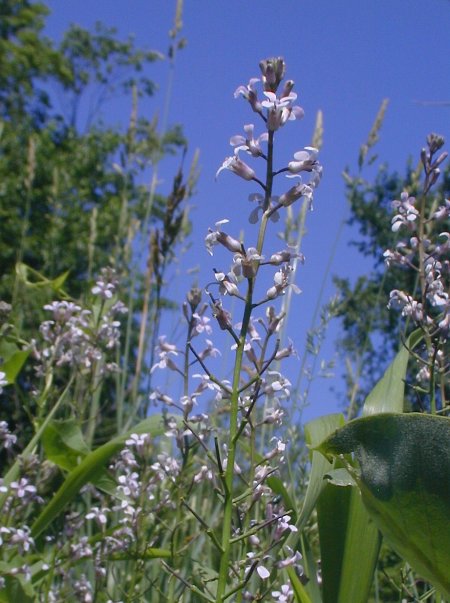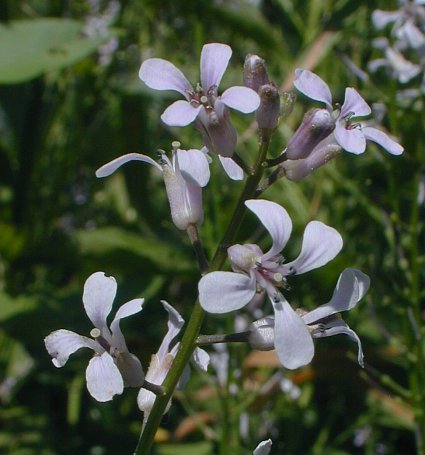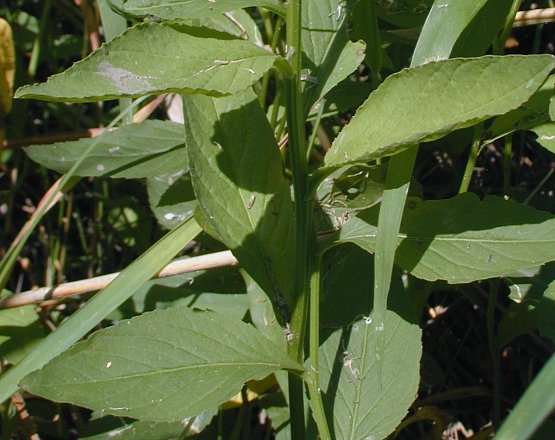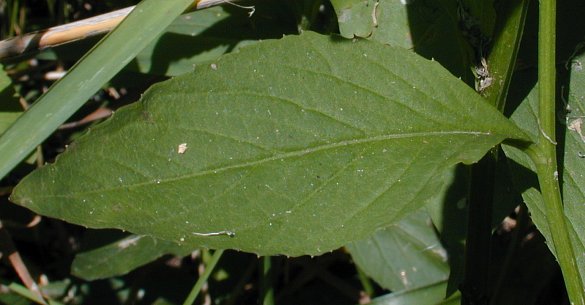Description: This herbaceous perennial plant is 1-3' tall, branching sparingly. It is relatively short-lived. The foliage consists of basal leaves and bolting stems with alternate leaves; most vegetative growth occurs during the spring. The stems are light to medium green, glabrous, and terete; sometimes they are slightly angular or slightly furrowed. The leaves are up to 5" long and 2" across, becoming smaller as they ascend the stems. They are usually more or less ovate, serrated or dentate along their margins, medium green, and glabrous. The basal leaves and lower alternate leaves are often pinnately lobed (pinnatifid); these lobes occur in 1-4 pairs near the base of each leaf. The upper stems terminate in erect racemes of flowers about 6-18" in length. Sometimes shorter racemes of flowers also develop from the axils of the upper leaves.

Each flower is about ¼" (6 mm.) across, consisting of 4 petals that are pale violet to nearly white, 4 pale gray or pale violet sepals, 6 stamens with violet anthers, and a pistil with a stout style. The petals are oblanceolate in shape and longer than the sepals. The sepals are oblong in shape and usually glabrous, although the tips of sepals on young flowers are sometimes finely hairy. The pedicels of the flowers are about 6-8 mm. long, ascending, and glabrous; they are green, greenish violet, or violet. The rachises (central stalks) and peduncles (basal stalks) of the racemes are green or purplish green and glabrous. The blooming period occurs during the early summer and lasts about 3 weeks. The flowers are often fragrant, particularly in sunny locations. The flowers are replaced by glabrous siliques (narrowly cylindrical seedpods) that become about ½–1" long at maturity. Each silique contains a single row of oblongoid seeds. Immature siliques are green to dark violet. The root system consists of a taproot. This plant spreads by reseeding itself.

Cultivation:
The
preference is partial sun to medium shade, wet to moist conditions, and
rich loamy soil with abundant organic matter. This plant is able to
tolerate temporary flooding.
Range & Habitat:
The native Purple Rocket occurs occasionally in east central and NE
Illinois,
while in other areas of the state it is uncommon or absent (see Distribution
Map). Habitats include wet to mesic deciduous woodlands,
particularly in floodplain areas along rivers and low-lying areas that
are prone to occasional flooding. This plant also occurs in soggy
meadows near wooded areas, including sunny areas that are adjacent to
small streams and drainage ditches. Purple Rocket is a non-weedy member
of the Mustard family that usually occurs in higher quality natural
areas, less often at degraded sites.

Faunal
Associations:
There is very little information about floral-faunal relationships for
this species. In sunny areas, the nectar of the flowers attracts bees
and butterflies; in particular, the butterfly Pieris rapae
(Cabbage White) is strongly attracted to the flowers. In shady areas,
the flowers appear to attract about the same number of bees, but fewer
butterflies.
Photographic Location:
Along a drainage ditch in a moist meadow at Judge Webber Park in
Urbana, Illinois. This meadow is rather weedy and located near a wooded
area. Purple Rocket also occurs in damp shady areas at Busey Woods in
the same city.

Comments: This is one of the more unusual members of the Mustard family because it is native, non-weedy, and has pale violet flowers. As these flowers become older, their color fades to white. In sunny areas, the elongated racemes of flowers can become exceptionally long – often comprising the upper half of the plant, if not more. However, they tend to be a little shorter and less showy in shady areas. Purple Rocket (Iodanthus pinnatifidus) is fairly easy to identify in the field because it doesn't closely resemble any other member of the Mustard family. Perhaps the most similar species is Blue Mustard (Chorispora tenella). This introduced species is rare in Illinois; it differs from Purple Rocket in having pink or purplish pink flowers and glandular hairs on its stems and pedicels. The siliques of Blue Mustard curve upward and they have longer beaks. Another member of the Mustard family, the introduced Dame's Rocket (Hesperis matronalis), has much larger flowers that are rosy pink. The petals of its flowers are well-rounded and overlapping, while the petals of Purple Rocket are more narrow and don't overlap.